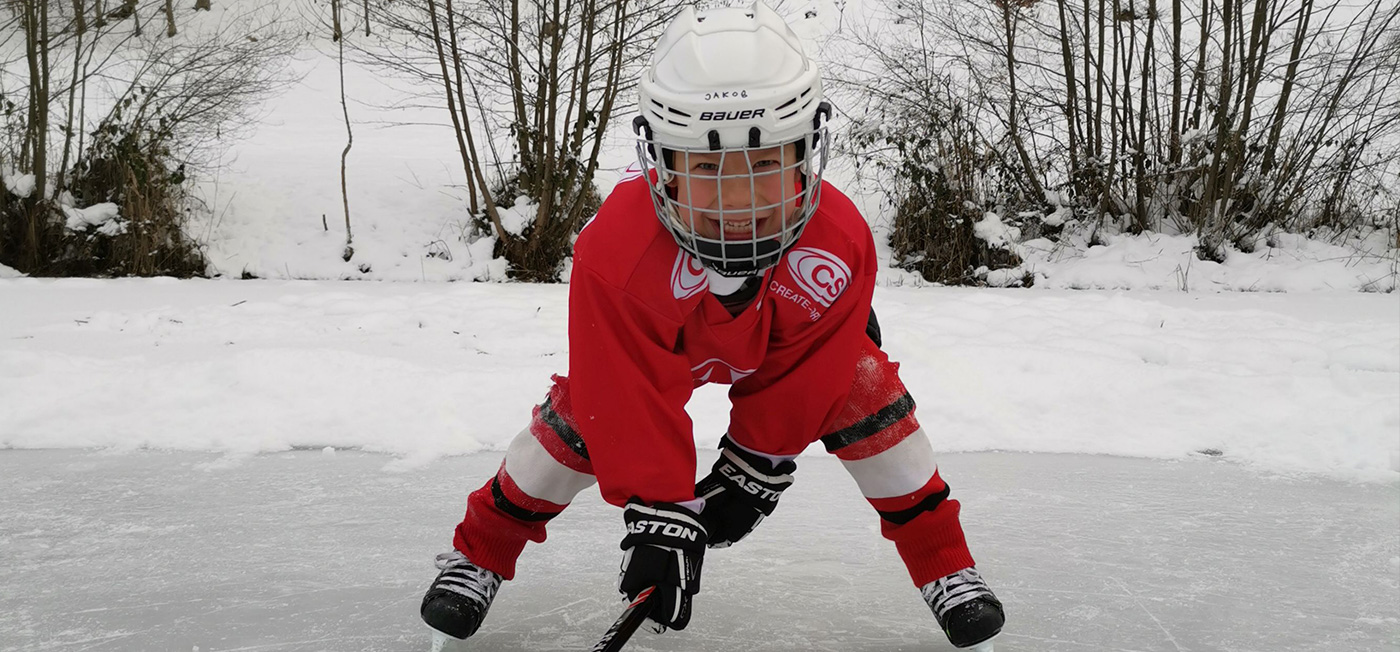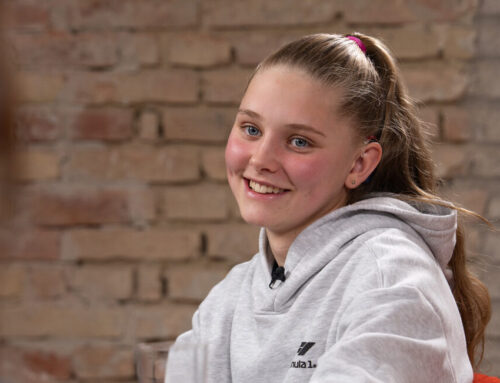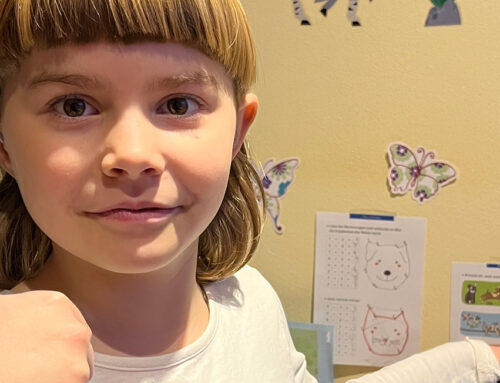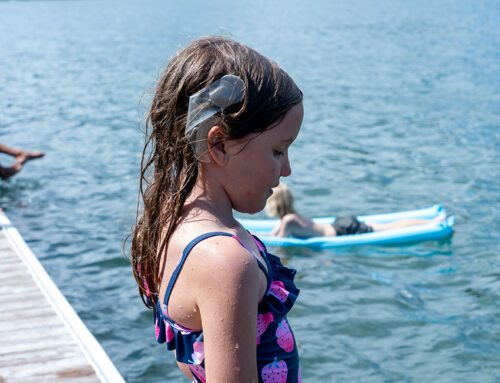BONEBRIDGE – a hearing implant for every situation
A 7-year old Jakob Ratz is an enthusiastic sportsman and he also enjoys going to school. His BONEBRIDGE ensures that he is fully involved in both situations.

“We all love sports”, Lisa Ratz introduces her family. Their older son Jakob cycles, plays tennis, football and loves skiing. He is particularly enthusiastic about ice hockey. Jakob was already acquainted with skates, field hockey sticks and the puck when he was three years old. For a few months now, school has also been part of his everyday life. His favorite subject there is math. “Because I’m good at it” he beams.
Jakob’s first year of school was full of corona-related lockdowns and homeschooling until a few weeks before our conversation. He is glad that the school is back. His mother is not only relieved that classroom instruction is possible again, but also that Jakob enjoys school and that he is getting along well.
A big shock
There was a time when Lisa Ratz feared that her son would have more difficulties in school. That’s because shortly after birth, Jakob was diagnosed with moderate to profound hearing loss in his right ear, caused by an auditory canal atresia. “That was a shock to me!” she recalls the moment of diagnosis. “Jacob was my first child, and there were no previous signs.”
In atresia of the auditory canal, the external auditory canal is not created, and the malformation can also involve the pinna or middle ear. In Jacob’s case, only the right ear is affected. While his pinna looks only slightly atypical and the middle ear is completely inconspicuous, the part of the ear canal not visible from the outside is closed just in front of the eardrum. Thus, the sound cannot reach the healthy inner ear naturally. However, if a bone conduction hearing aid or implant is used to conduct sound directly into the cochlea via the skull bone, the sound can be processed in a natural way.
Is one healthy ear not enough?
“A friend of ours had a diving accident and cannot hear on one side anymore. So I thought to myself, what if that had happened to Jakob´s “good side” ?” But the challenges of school also came to mind for the mother of two, as classrooms in schools are rarely quiet. But to understand speech in noisy surroundings requires hearing on both sides.
As early as 2008, one U.S. study showed that children with unilateral hearing problems more often experience problems in speech development, social-emotional development, and in school than their peers without hearing impairment. Up to 35 percent of children with hearing impairment must repeat at least one school year, and up to 60 percent need tutoring for one or more years.
At the summer meeting of the “Danube Society of the Otolaryngology” in June 2021 in St. Pölten, Univ. Prof. Dr. Susan Arndt, Managing Senior Physician at the ENT University Clinic in Freiburg and Deputy Head of the Implant Center at the same clinic, also pointed out the accumulation of behavioral problems in unilaterally deaf children. For example, they tend to be more hyperactive. The University Hospital in Freiburg is even investigating a possible connection between unilateral deafness and attention deficit hyperactivity disorder (ADHD).
Finally, two healthy ears also make acoustic spatial orientation and speech understanding possible, even in noisy settings.
Living with both sides
“We felt it was right to fit the right ear with a hearing aid to show our child that something is happening on that side in life, too,” Lisa Ratz says. Initially, Jakob used a conventional bone conduction device that was pressed against his temples with a headband. “At a certain age, it probably becomes easier for girls with a headband than for boys. I sewed the holding device for the bone conduction system into different caps as well.”
However, Jakob always had to wear one of those headpieces when he wanted to use the device. While researching alternatives on the Internet, Lisa Ratz came across the pressure-free device ADHEAR, which is held with an adhesive adapter behind the ear. The ADHEAR was barely visible under Jakob’s hair, yet so easy to use that he was able to change the batteries on his own while he was still in kindergarten. “Jakob has always done well without a hearing aid, but we did notice the difference.” If the ADHEAR wasn’t there first thing in the morning, he asked for it.
Just before starting school, at six and a half years old, Jakob received a bone conduction implant – BONEBRIDGE.
Hearing on both sides brings many benefits
Mother Lisa complains that many doctors don’t provide enough information about different options – at least for a child like Jakob, who at first glance seems to get along fine without a hearing aid. On several occasions, Jakob was being compared to the ski jumper Gregor Schlierenzauer, who, after all, also manages well with only one hearing ear.
Yet, the story of the successful Austrian athlete could serve as an argument for hearing on both sides. When Schlierenzauer was working on his comeback after the injury in the summer of 2016, his personal trainer Marc Nölke told the “Kleine Zeitung” that the results of neurological tests of an area in Schlierenzauer’s brain showed it was underactivated, probably because of his single-sided deafness. “For a long time, he was able to compensate for this asymmetrical activation pattern and its effects. But at some point, even the most stable compensatory structures break down.” The result, was, among other things, a problem with balance, which is essential for any ski jumper.
According to Nölke, Schlierenzauer tried to counter the potential consequences of his single-sided deafness with special training. And the Ratz family decided on early hearing care for Jakob’s impaired side and implantation when he was six years old.
Implantation in children
The road to the implantation was not so easy for the family Ratz. Jakob and his parents were also satisfied with the ADHEAR. However, the one thing that was annoying was the need for frequent change of the adhesive adapter, as Jakob performs sweaty sports.
Fortunately, Jakob´s parents met Thomas Ringhofer, MSc, a clinical tehcnician who cared for Jakob´s bone conduction device. He suggested them an alternative option: the bone-anchored hearing implant called BONEBRIDGE.
“At the time, our ENT doctor said it was too early for Jakob to get an implant,” his mother recalls. The family wanted to get a second opinion and turned to the implant team of the ENT department at Klagenfurt Regional Hospital. In fact, the BONEBRIDGE is suitable for children from the age of five. The optimal placement is determined before the surgery using obligatory CT scans, even on small heads and in thin skull bones.
There are currently four ENT specialists active in Carinthia. They are experienced in the indication and surgery of hearing implants and at the moment, there are such teams at 15 clinics throughout Austria.
The surgery was uncomplicated
Some acquaintances of the family were skeptical before the surgery. They never noticed that Jakob has problems, even when he was not using his hearing aid. “Of course, when you have a surgery, you worry at first!”, Lisa Ratz has to admit. “But I come from the medical field. I trust the staff.”
Jakob, whom she prepared for the surgery with some YouTube videos, had no fear of the surgery. “Overall, everything was totally straightforward. I think all the preparation before and after the anesthesia requires more effort than the insertion of the implant. Jacob was pain-free after the surgery. The surgery is often made out to be more problematic than it ultimately is.”
The initial fitting two months later brought another surprise. “Jakob was familiar with hearing on the right from the ADHEAR. But with the BONEBRIDGE, it was even louder and clearer.” He now wears the audio processor all day long.
“We have the pool in the backyard. When Jacob goes in, he puts the processor down. But kids who are implanted on both sides can even go in the water with the WaterWear.” The only thing he hasn’t figured out yet is how to fit the processor under the helmet when playing ice hockey – but he already has a bike helmet that fits!
Hearing implant in school
After the initial activation of his BONEBRIDGE, the first day of school soon awaited Jakob. For his classmates, the implant and associated processor were never an issue.
Lisa Ratz got support from the state of Carinthia from Mr. Berger, an elementary school teacher who is himself fitted with hearing aids on both sides. He discussed the special challenges for Jakob with her and gave his advice. Most recently, he spent a two-hour lesson explaining the hearing process to Jakob’s classmates and creating understanding for Jakob’s situation.
“Jacob would be prepared for being laughed at, but fortunately he hasn’t had any bad experiences so far,” his mother is happy. “On the contrary, many kids think the magnet thing looks cool.” For the time being, the family is no longer worried about everyday school life, and from Jakob’s perspective, his sporting future also seems assured. He adds: “I’ll probably become a professional ice hockey player!” When his future fans cheer Jakob on then, he will hopefully hear that from both sides with the help of his BONEBRIDGE – just like everything else in life.






